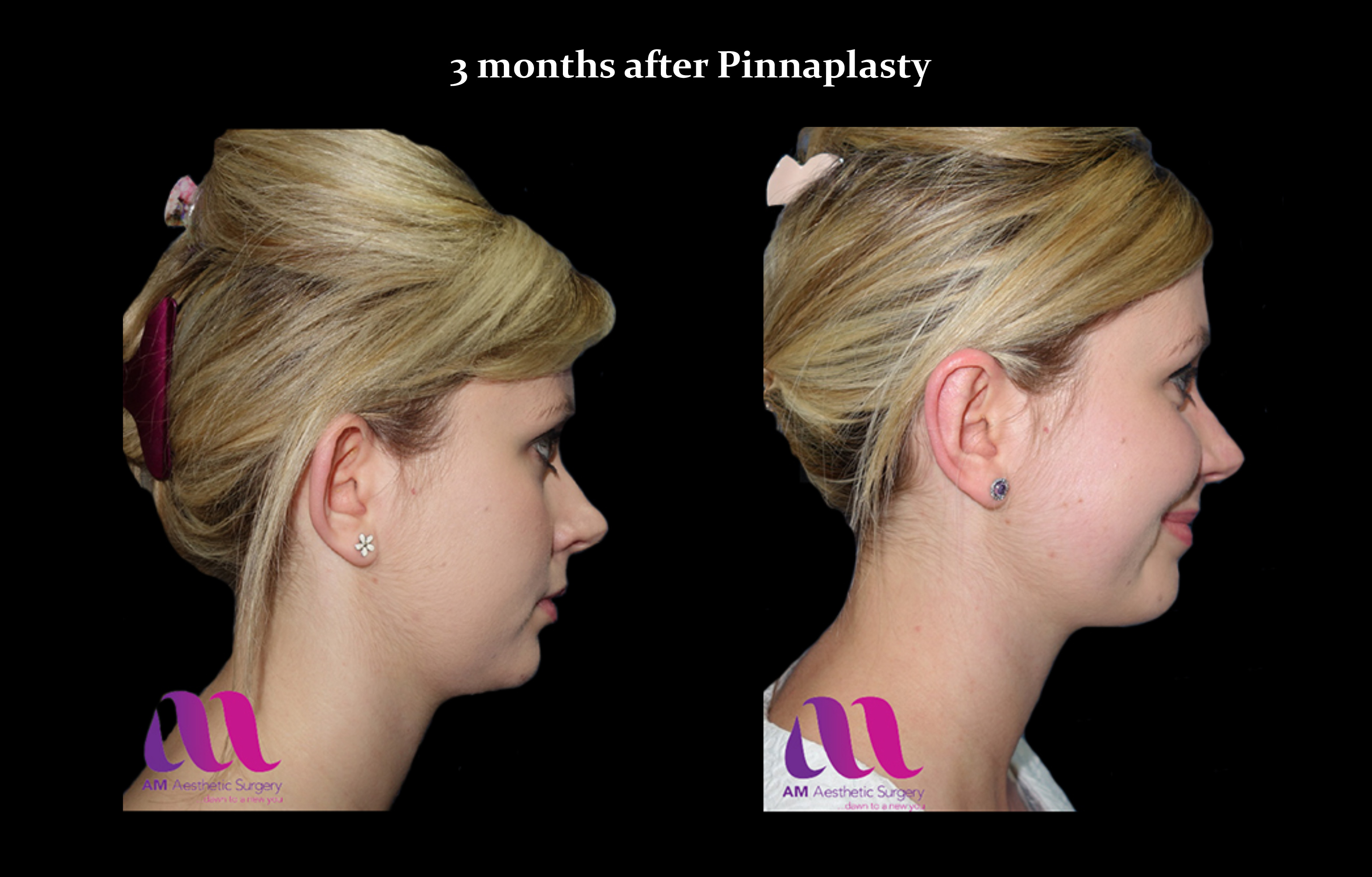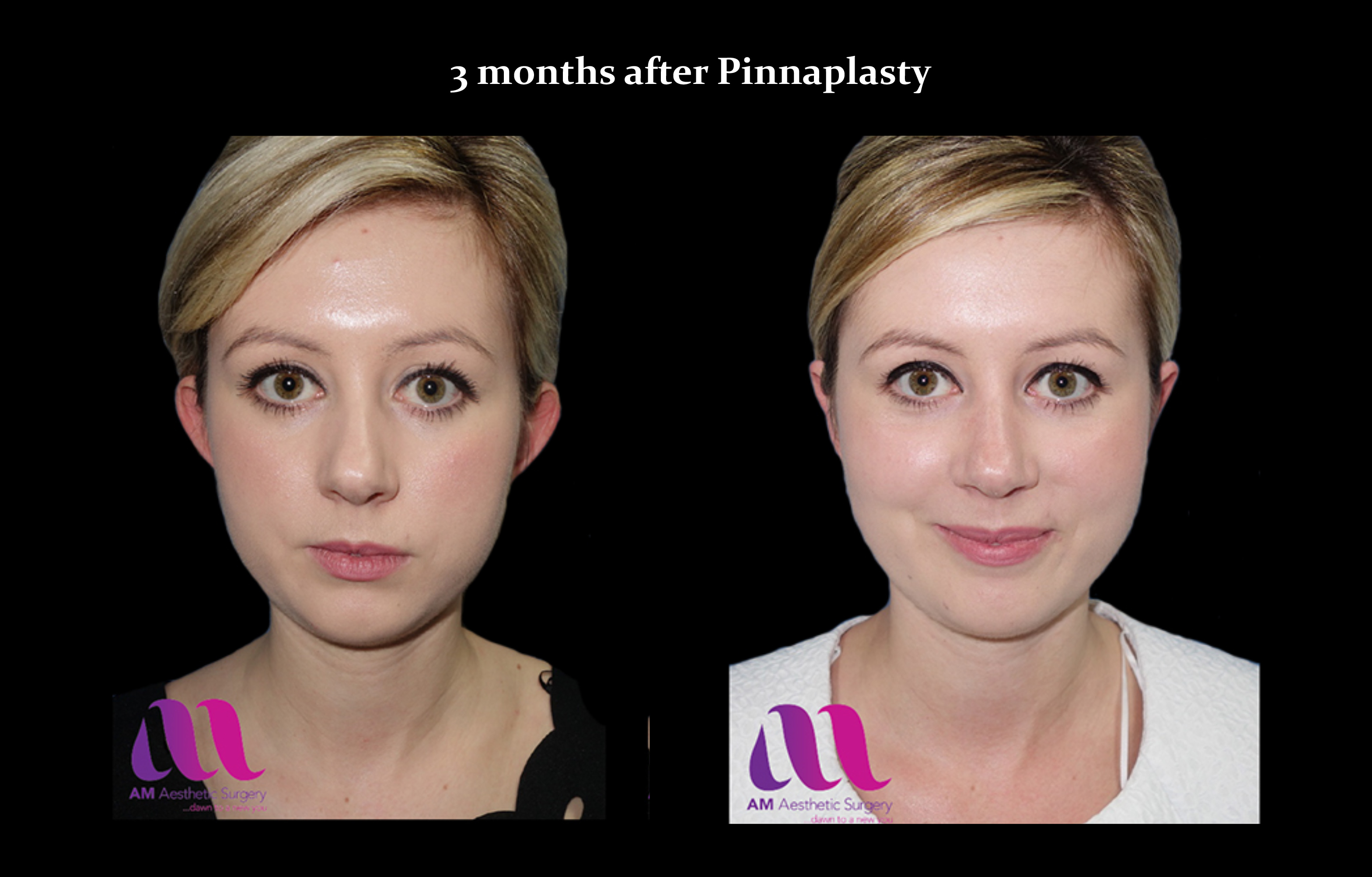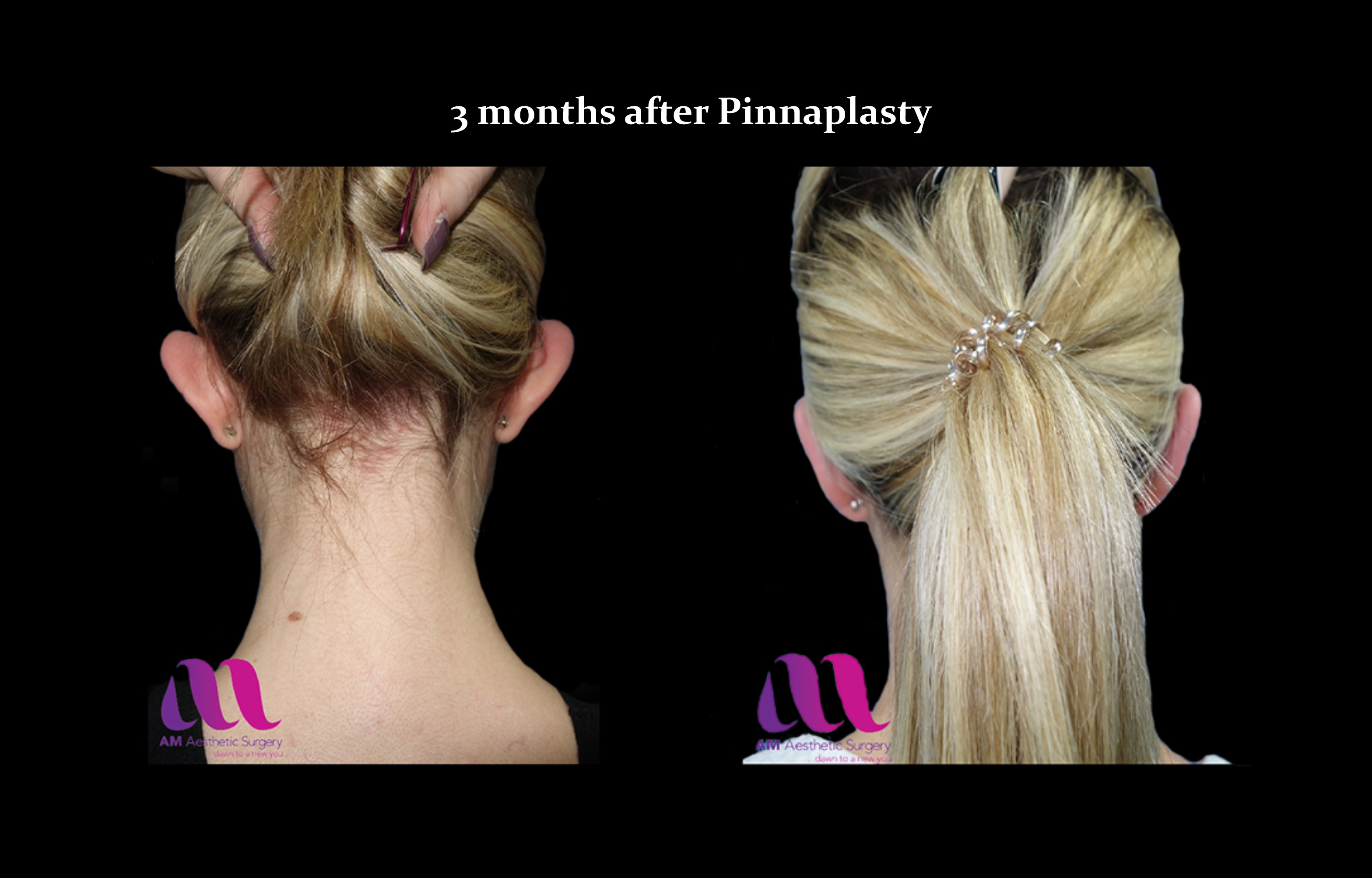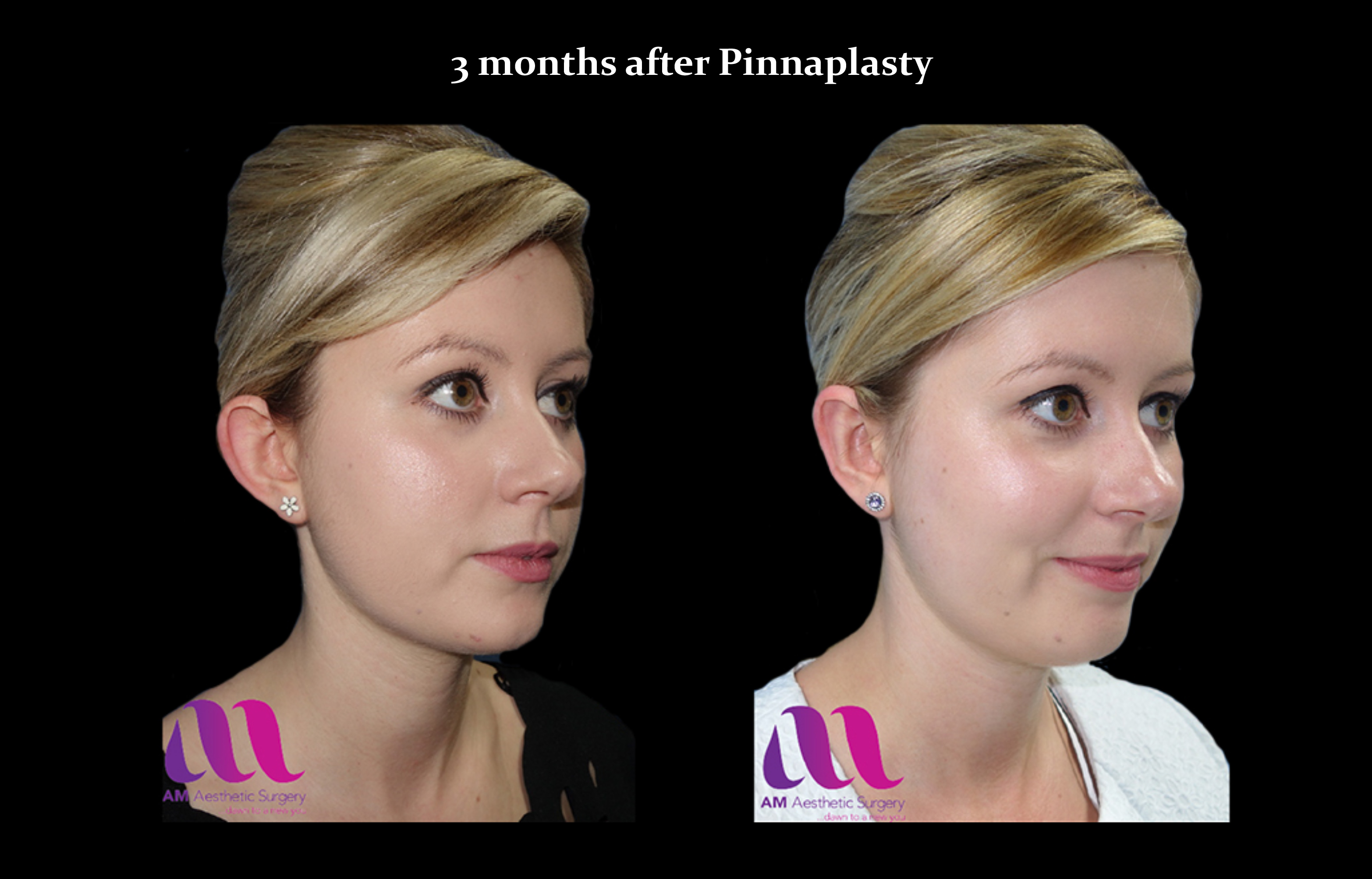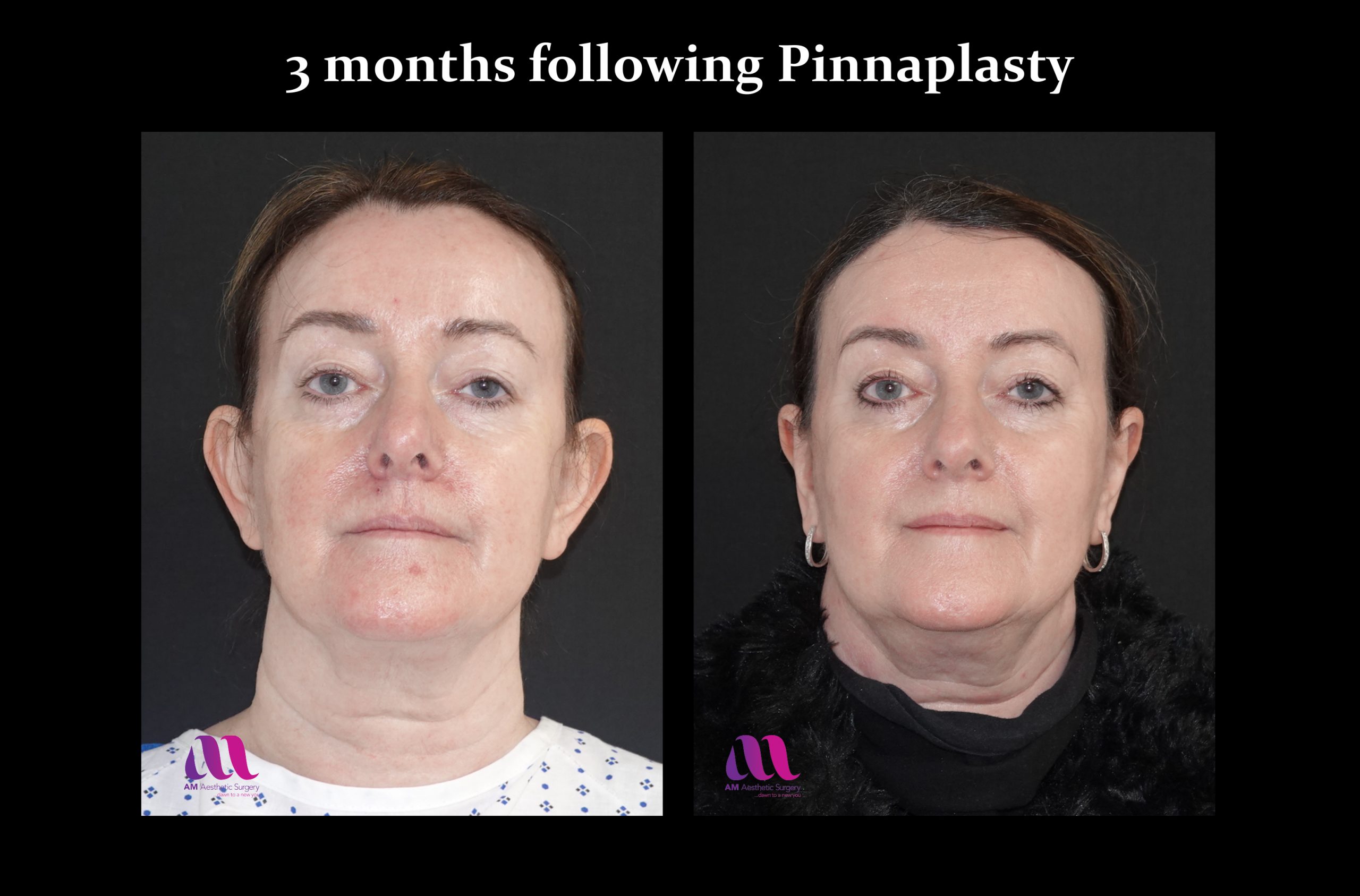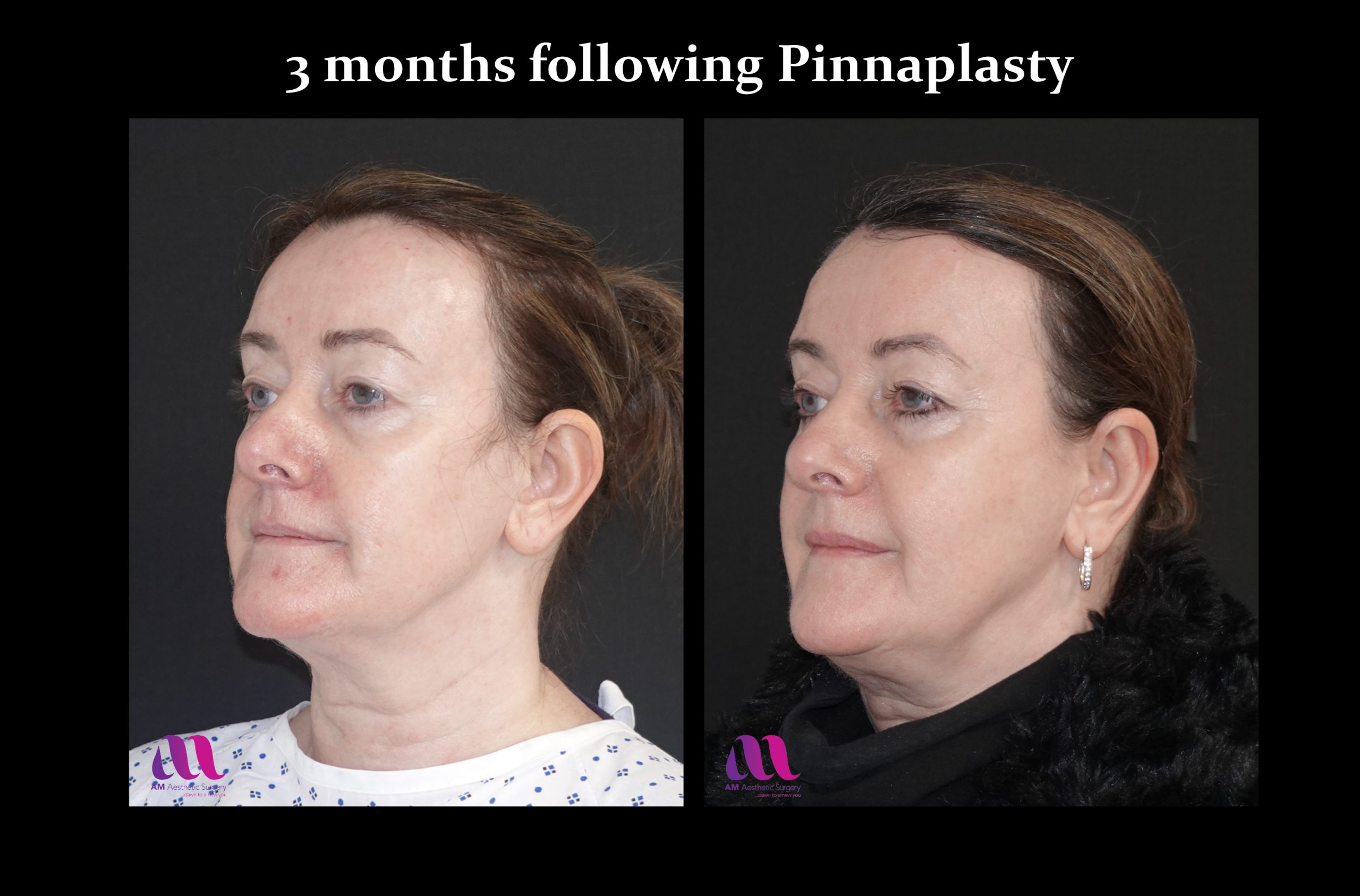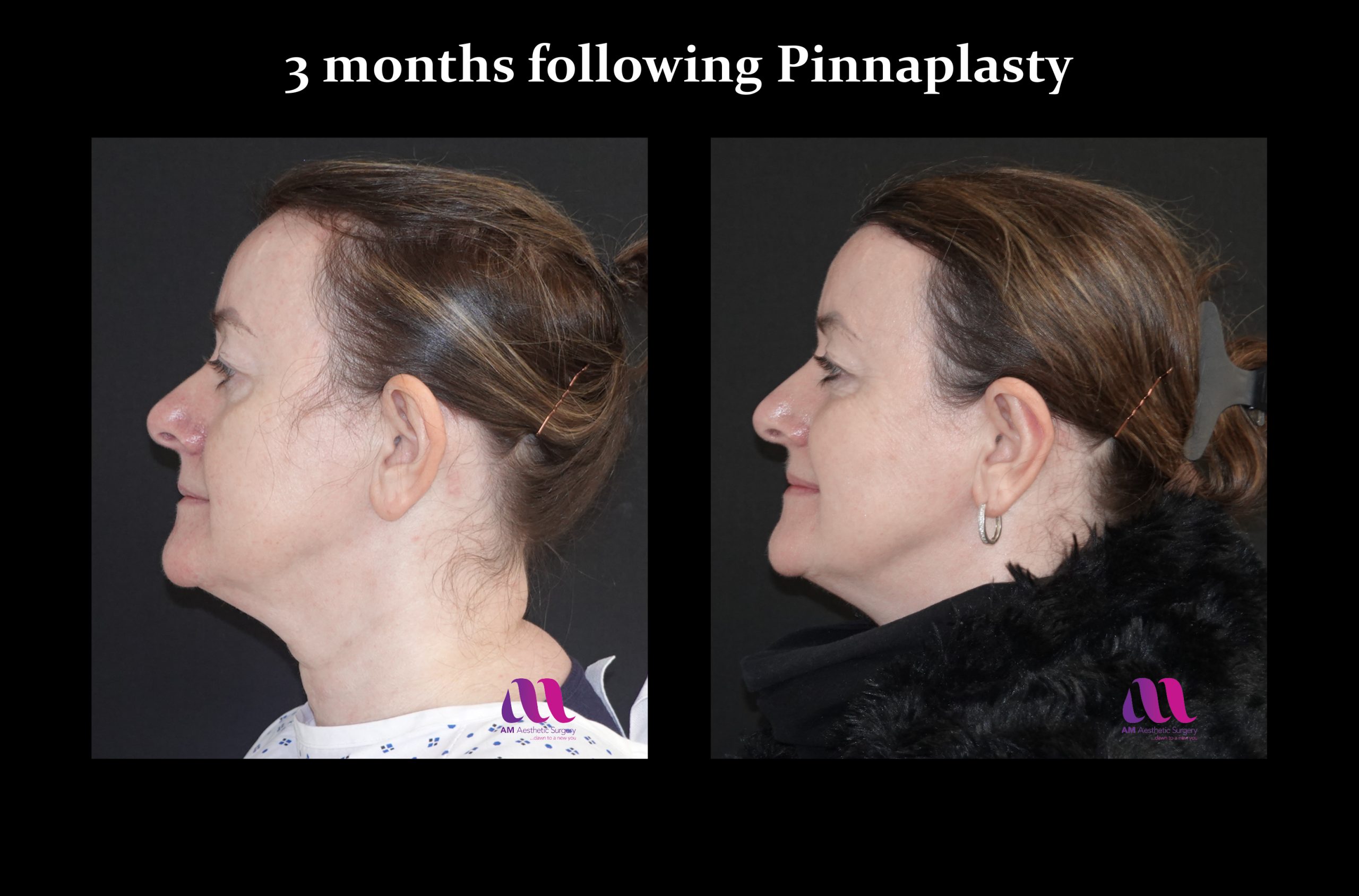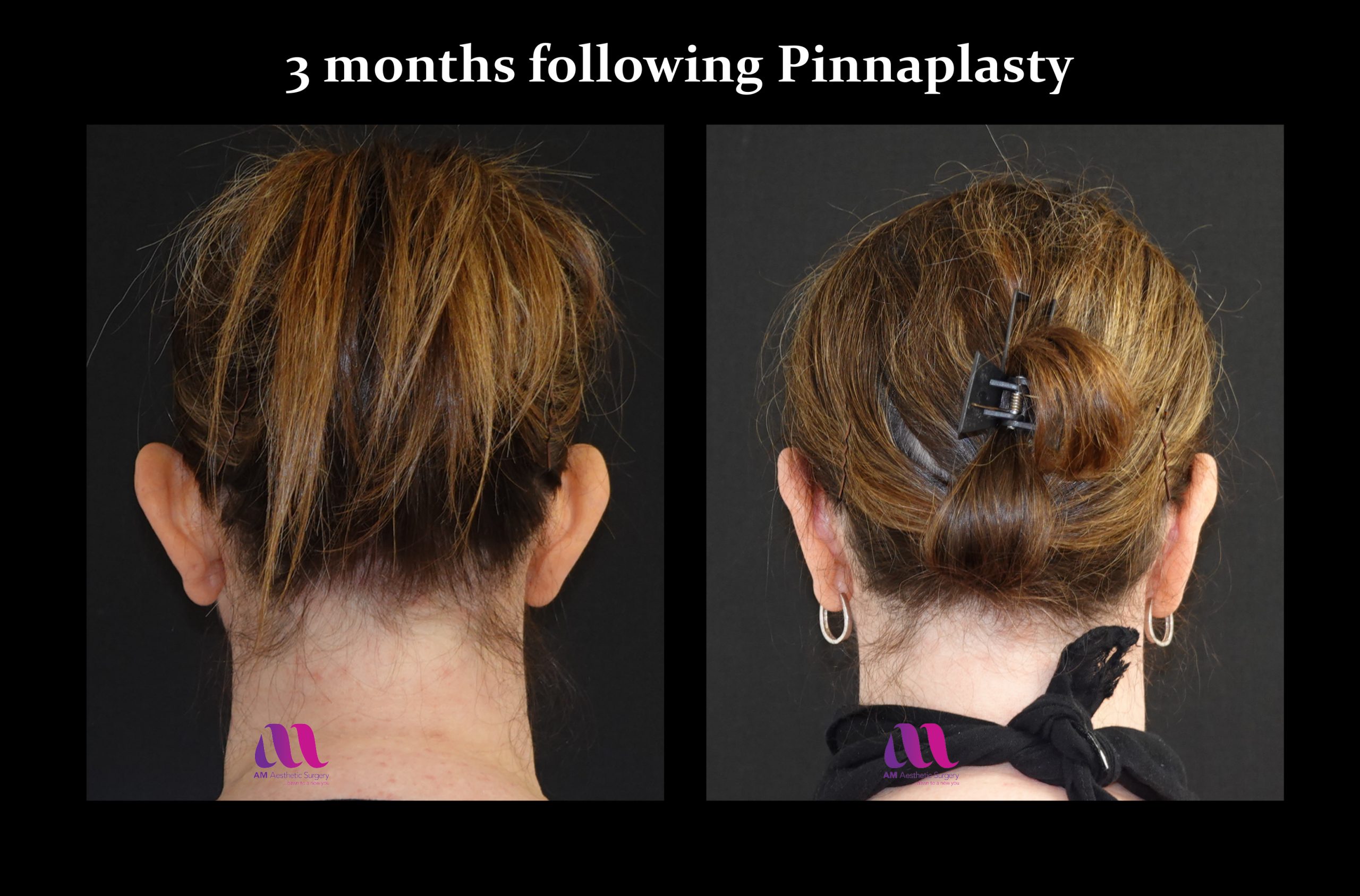Unfortunately, prominent ears is something that bothers a person right from their childhood days. Children tend to get teased about them at school and unfortunately parents may not realise the amount of grief that the child may be getting. Children tend to wear their hair down to cover the ears and may even end up avoiding sports like swimming and gymnastics to avoid wearing their hair up.
Ears come in various sizes and they could potentially be too big in relation to the rest of the face. This usually not an issue unless the angle between the ears and the side of the head is exaggerated, making them stick out. This is mainly either due to the antihelical fold not being developed or due to a deep conchal bowl. A Pinnaplasty procedure helps address this by creating this fold and bringing the ears back towards the side of the head and the conchal bowl can also be reduced.
Mr Mahajan carries out a detailed examination of the ears in relation to the rest of the face to determine the appropriate intervention for the best possible outcome. Necessary changes and the means to achieve them are then discussed in detail with the patient. However, it is very important to understand that ears are individual and it is not possible to have someone else’s ears. Instead, changes can be made to your ears to make them look as good as possible. If your expectations are realistic, you will always be happy, if not, you will always be unhappy irrespective of how good a job your surgeon might have done!
This procedure can be combined with eyelids lift, brow lift or fat transfer to areas in the face or Botox and fillers to help achieve a global rejuvenation of the face.
WHO IS PINNAPLASTY FOR?
- Ladies or gents with prominent ears
- Ladies or gents who feel their ears are very large
- Ladies or gents who do not like the shape of their ear
WHAT DOES A PINNAPLASTY ACHIEVE?
- Reduces prominence or the ears by creating the ear fold or reducing the conchal bowl.
- Can reduce size of the ears, but with additional scars.
- Can improve shape of the ears by addressing particular parts of the ear.
PINNAPLASTY TECHNIQUES
- Suture technique – Modified Mustarde technique
- Cartilage scoring technique
- Cartilage reducing technique
- Metal implants technique – ‘Ear fold’
PINNAPLASTY NEED-TO-KNOW INFO
Duration of surgery: About 1 to 1.5 hours
- Anaesthesia: General Anaesthetic or Local Anaesthetic
- Duration of inpatient stay: Day case procedure
- Wounds healed in: 1 week, ears need to be protected at night for 6 weeks.
- Scars matured in: Settle in 3 to 6 months, fully matured in 12 to 18 months
- Back to light work (Desk job): 1 – 2 weeks
- Back to cardiac exercise / fast walking: 2 to 3 weeks
- Back to labour intensive work / Exercise: 6 to 8 weeks
- Sexual activity: 6 to 8 weeks
- Able to drive: 2 weeks (Should be able to apply emergency stop)
- ‘Long haul’ flights / holidays: Avoid four weeks before and after. Short flights are okay but take precautions.
- Shower / bath: Keep dressing dry for one week but pamper yourself with a sponge bath.
- Sun bathe: Keep the scars covered or protected with a high factor sun protection cream until they mature in about a year or so.
- Garments: Head bandage for 1 week
- Post-operative review: 1 weeks, 3 months (As often as necessary if clinically indicated)
- Post-Operative pain / discomfort: 2 to 5 days
•Potential risks: (Every effort is made to reduce the risk of complications, but potential risks are) bleeding, bruising / swelling, infection, wound dehiscence, scarring (hypertrophic / stretched /sensitive), asymmetry, under correction, over correction, persistent or recurrent prominence, numbness, risks associated with general anaesthetic, blood clots in legs or lungs and unfavourable outcome.
“I am now 4 months post op from a bilateral pinnaplasty and I couldn’t have hoped to achieve a better outcome!
I’ve never been under general anaesthetic before, and as this procedure was under two hours I decided to have my treatment performed under local, which also meant I was discharge quickly after and soon recovering in my own bed. In the first few days following surgery I had virtually no pain from my ears, my only discomfort was the head bandage as it was quite tight which made it difficult to sleep in a comfy position, but I only had to wear it for a week.
Seeing Mr Mahajan was the best decision, as he made me feel completely at ease at my initial consultation, during surgery and in my follow up. This treatment has helped my confidence and I can’t wait to show them off! What a friendly, humble and competent surgeon. Thank you so much.”
//www.realself.com/review/spire-elland-hospital-ear-surgery-bilateral-pinnaplasty
“My ears have always bothered me, which it stopped me from tying my hair in a ponytail, going to swimming and the gym, unless I had to cover them. However, finally I had the chance to get otoplasty surgery done and I was motivated in every way. After meeting MR Mahajan, I believed that I will have it done in a couple of weeks and was looking forward to my surgery as he explained everything well and put me at ease. After having the otoplasty surgery done, I got some pain around my ears but honestly, the excitement of having to take off the bandage of my ears and seeing the new ears puts the pain at ease. The pain is only moderate and can be controlled with paracetamols. However, the big excitement hit me when I looked at the mirror for the first time after taking off my bandage. I was shocked, over the moon and did not believe it was me with such beautiful, natural and pinned ears. It is definitely worth doing it now than later, and my self-confidence is better than it’s ever been and it’s all thanks to Mr Mahajan.”
//www.realself.com/review/hx5-9eb-ear-surgery-new-beautiful-natural-pinned-ears
Mr Mahajan will acquire a detailed history from you about your concerns and your medical history. He will take the time to understand your desires and discuss in detail as to how he can achieve the results you want. A detailed examination involving assessment of the ears and facial contours, overlying skin and underlying cartilage will be noted. Measurements will be taken as necessary to gauge the degree of the problem.
Depending on your examination a treatment plan will be formulated tailored to your needs. Mr Mahajan will discuss surgical options with you. You will together be able to decide the procedures that will be used to achieve your desired results. There is limit as to how much things can be altered depending on your underlying cartilaginous structure, this will be assessed and explained to you. The procedure can be done under a general or local anaesthetic. This will be explained to you and you can choose what you wish to have.
Mr Mahajan usually carries out a modified Mustarde pinnaplasty procedure to help address the prominence of the ears and make the necessary amendments to produce the desired results. Pattern of the incisions, procedure and subsequent scars will be discussed in detail and you will be given an opportunity to probe into any aspect of the proposed procedure. Once you decide to go ahead following the consultation, you will be required to attend the pre-assessment clinic to ensure your suitability for the procedure under general anaesthetic. You will need to stop smoking (including electronic cigarettes and nicotine patches) and stop any anticoagulant medication such as Aspirin, Warfarin, etc as suggested by Mr Mahajan.
You will be admitted to the hospital on the day of the procedure. The operation will be done under general anaesthesia or local anaesthesia as has been decided at the consultation. It will be carried out according to the technique that was planned at the consultation. This will depend on the characteristics of your ears and will involve using the approach discussed before.
Mr Mahajan does a modified Mustarde pinnaplasty procedure that involves making the incision behind your ear. He then uses special permanent sutures to create the ear fold uniformly and smoothly. The suture technique helps him control the degree to which the ear needs to be set back with the results being apparent at the end of the procedure, unlike the cartilage scoring technique when end results are only apparent after the cartilage has healed in about 6 weeks’ time. In addition to this Mr Mahajan may use concho mastoid sutures or other ancillary techniques to help deliver the best possible outcome.
At the end of the procedure, the ear are held in their new position with a padded head bandage that secures them in place while they are healing. This will need to stay for a week until you see Mr Mahajan again in the clinic.
The procedure can take about 1 to 1.5 hours to do depending on the complexity of the case. Mr Mahajan will dedicate as much time as is necessary to create your new aesthetically pleasing form and achieve the results you desire.
Following your procedure, you will be taken to your room, once you have recovered from the anaesthetic. You will be cared for to the highest standards by our well-trained nurses. You will need to rest in bed with the back propped up to minimize swelling and bruising. Once you have recovered enough after the surgery, you will be encouraged to sit out of the bed and mobilise to reduce the risks of blood clots in your legs or lungs. You will have some pain and discomfort for 2 to 5 days, but we will ensure that you are comfortable with adequate analgesia.
You can go home as soon as you are comfortable enough to go home. This is usually the same day as your surgery. You will have absorbable sutures which will not have to have to be removed. Scars are unavoidable following any surgery, but Mr Mahajan aims to make these as neat as possible. Your ears will be swollen immediately following the surgery. Over the next few months the swelling will gradually go down and the contour of the ears will improve.
You will be seen 1 week following the procedure to ensure that your wounds have healed well. You will need to wear a head band at night for 6 weeks after this initial visit. After this, you will be seen again in 3 months’ time to assess the results when the swelling has settled reasonably. Mr Mahajan will be available to see you at any time following the procedure should there be any unexpected problem.
Is Pinnaplasty for me?
If you have prominent ears and are conscious about their appearance or are being teased about them, then a Pinnaplasty will help set them back to reduce their prominence and blend in on to the side of your head. The prominence of the ears has to be significant enough to outweigh the risks associated with having the procedure. It is not for people who want their ears taken in by 2-3 millimetres. If this is what you desire then there may be more important issues of body image to address, rather than undergoing surgery. Most importantly, expectations need to be realistic. If they are then you will always be happy with the outcome, if they are not and if you are looking for millimetre perfection, then you may never be happy even if the surgeon has done an excellent job.
What is the most important consideration prior to deciding to have a pinnaplasty procedure?
Pinnaplasty involves permanent changes to your ears that can be difficult to reverse as cartilage and skin may be trimmed away to shape your ears. Revision pinnaplasties can be complex procedures and has every risk of making matters worse. Ideally one should aim for a once off procedure and hope to be happy with the results. It is important to understand that a patient cannot have someone else’s ears, but can have an improvement in the way their ears looks.
How do I know if my surgeon is qualified in the field of Plastic Surgery?
MB BS, MB BCh or MB ChB is the basic medical degree of any doctor. Your plastic ‘surgeon’ should at least be a ‘surgeon’. Doctors who receive adequate ‘basic’ surgical training in the UK are awarded Fellowship (FRCSI, FRCS, FRCS Ed, FRCS Gl – in the older generation of surgeons) or Membership (MRCS – in the younger generation of surgeons) of the Royal Colleges in the UK. Doctors or Surgeons, who believe in having a scientific foundation to their practice, spend further years doing research in their fields and are awarded Research degrees such as MSc, MMedSc, MPhil, MD or PhD. Surgeons who ‘train specifically in the field of Plastic surgery’ are awarded FRCS (Plast). These surgeons are then entitled to be on the “Specialist register for Plastic Surgery” with the General Medical Council (GMC).
How do I choose amongst the Plastic Surgeons who fit the above criteria?
‘Safe’ and ‘beautiful’ results are dependent on ‘experience’ and ‘expertise’ of your plastic surgeon. Mr Mahajan is a highly trained and experienced plastic surgeon who is a Consultant Plastic Surgeon at the Bradford Teaching Hospitals NHS Foundation Trust / Calderdale and Huddersfield NHS Foundation Trust and is the Director of the prestigious Plastic Surgery and Burns Research Unit (PSBRU) at the University of Bradford. He has worked in world-renowned centres for aesthetic surgery in Belgium, Sweden and Switzerland in addition to his training in the UK. He is a full member of the British Association of Plastic Surgeons (BAPRAS), British Association of Aesthetic Plastic Surgeons (BAAPS), European Association of Plastic Surgeons (EURAPS), UK Association of Aesthetic Surgeons (UKAAPS), Association of Breast Surgeons (ABS) and is on the Specialist register for plastic surgery with the General Medical Council (GMC). Surgeons are only awarded membership of these associations if they are properly qualified and it is a reassurance for you that you are in safe hands. In addition to this, it obviously helps if your surgeon has travelled the world to enhance his training in premier institutes to learn from leading surgeons in their fields. It also helps if your surgeon believes in practicing “evidence based medicine” by engaging in research activities to help establish a scientific background to his / her clinical practice.
Where will my surgery take place?
Your surgery will take place in ‘local’ reputed hospitals such as the Yorkshire Clinic or the Spire Elland Hospital, where you will be able to return to ‘anytime’ after the operation should there be any concerns.
Which type of Pinnaplasty procedure would suit me best ?
A suture technique pinnaplasty tends to produce the most harmonious result. There is more control over creating the fold smoothly with this technique with the results being apparent at the end of the procedure, unlike the cartilage scoring technique when end results are only apparent after the cartilage has healed in about 6 weeks’ time. There is also an increased risk of creating a sharp fold, skin necrosis or bleeding in front of the ear with the cartilage scoring technique. If the ears are prominent predominantly due to a deep conchal bowl, then a cartilage reduction technique may be necessary. The metal implants technique (Ear fold) is claimed to be minimally invasive technique with a shorted operating time. However, Mr Mahajan does not believe in it for various reasons. The suture technique involves contouring the fold in 3 to 4 places to get as nice a curve to the fold as possible. On the other hand, the metal implants are generally placed in one part only. Additional clamps can be used, but that then defeats the purpose. The scars have to be in the front of the ear, although these are small, if a patient has a tendency to develop a keloid scar, then it would obviously be a big problem. The implants sit on the cartilage covered by very thin skin on the front of the ear, putting them at risk to be palpable and visible.
How much will the procedure cost?
Cost of a pinnaplasty can be about £2000 to £2300 depending on whether the procedure is done under local or general anaesthetic. Mr Mahajan will discuss this with you when you meet him. You may find cheaper deals with firms that consider cosmetic procedures as a business, but may end up compromising on safety, quality and convenience. Although pinnaplasty may be considered as a cosmetic procedure, it is a plastic surgical ‘operation’ and you do need to appreciate this and consider it with all the seriousness that it deserves. Medical tourism has certainly made costs cheaper, but the very fact that you are boarding a long haul flight puts you at risk of blood clots in your legs or lungs that can be life threatening. There are obviously other matters to consider such as qualifications, experience and expertise of your surgeon / anaesthetist apart from the ability to see your surgeon again should there be a problem after you have flown back home.
Am I too old or too young to have a pinnaplasty procedure?
The ear is almost fully (90%) grown in size by the age of 6 years. It is advisable to wait at least until then prior to carrying out a pinnaplasty procedure. One needs to take in to account the fact that the child is attaining school going age and procedure should be planned around this to pre-empt any issue of teasing that the child may end up having in school.
On the other hand, a patient is usually not too old to have a pinnaplasty procedure done. If it is something that has always bothered them, then they should contemplate having it done. Parents often don’t realise the impact of prominent ears on their child life as it is best to have it done in the younger years.
Is it possible to have a natural looking ears?
Mr Mahajan always aims to deliver as natural looking a ears as possible. However, a lot depends on the pre-existing size and shape of the ears. This will be discussed in detail with you at the time of the consultation.
Do I need to stop my medication?
If you are on the oral contraceptive pill, you will need to stop these 4 weeks before the procedure to reduce your risks of blood clots in legs or lungs. Also, you will need to stop any blood thinning drugs. Aspirin and Clopidogrel will need to be stopped a week prior to surgery. Warfarin, Dabigatran etexilate, Rivaroxaban and Apixaban need to be stopped 4 days prior to surgery. Mr Mahajan will discuss this with you in the pre-operative consultation.
Will I need to have a general anaesthetic?
You can choose to have the procedure done either under a general or local anaesthetic. It will take about 1 to 1.5 hours to do the operation for you. Your anaesthetist will be fully qualified and a member of the Royal college of Anaesthetists. He will ensure that you have a smooth anaesthetic procedure and are comfortable during your recovery.
Are there any risks?
Every effort is made to reduce the risk of complications, but potential risks are) bleeding, bruising / swelling, infection, wound dehiscence, scarring (hypertrophic / stretched /sensitive), asymmetry, under correction, over correction, persistent or recurrent prominence, numbness, risks associated with general anaesthetic, blood clots in legs or lungs and unfavourable outcome.
How long will I have to stay in the hospital?
You will be able to go home in 2 to 3 hours following the procedure , once the nurses are happy that you have recovered well from your anaesthetic. You will be discharged from hospital when you are comfortable enough to go home.
When will I be seen again after I am discharged from the hospital?
You will usually be seen by Mr Mahajan one week following your procedure to ensure that the wounds have healed well. At this stage all your dressings will be removed. Following this initial review, you will be seen again in 3 months. However, if there are any concerns, you will be seen by Mr Mahajan as often as is necessary.
Is there anything that I need to look out for?
Although you will only be discharged from the hospital when we are satisfied that you are doing well following your surgery, you do need to look out for sudden increase in swelling of the face near the ears, disproportionate pain, any signs of infection such as feeling unwell, temperature, discharge or foul odour from the bandage. Some discomfort is common in the first day or two, but if you have disproportionate pain or feel that the bandages are too tight or have slipped off, please contact us. One should also look out for any painful swelling of the calf or shortness of breath that might suggest a blood clot. If this happens, please contact us immediately.
What if I have a problem after I am discharged from the hospital?
You will be discharged from the hospital when it is safe enough to do so. However, in the event of any unexpected problems, you can contact us any time on 0800 246 5636.
What position can I sleep?
Immediately after the procedure, you will be most comfortable lying on your back with the back propped up at 45 degrees or so to minimise swelling in the face for the first few days.
Will I need to wear any special dressings / garments?
You will have a head bandage following the procedure, This will need to stay on for a week, until Mr Mahajan sees you again in the clinic. The bandage will then be taken off, but you will need to wear a loose head band to secure the ears in place at night, so that you don’t accidentally flip them forwards in your sleep!
Will I be in pain?
Patients do tend to have some pain and discomfort for the first 2 to 3 days, but you will be kept comfortable with adequate analgesia. It is advisable to take Paracetamol six hourly on a regular basis for the first 24 to 48 hours and then as necessary after that. Patient do need to be aware that it will feel a bit tight in the neck area after the procedure, but this feeling eases with time.
Will my ears be swollen, will I be bruised?
There will be some bruising of the ears. This will settle in 2 to 4 weeks, depending on the degree of bruising. Your ears will indeed be swollen immediately after the procedure. The swelling takes time to settle and it will be significantly less three months following the procedure. It continues to further settle gradually after.
Do I need to massage my ears?
You will need to massage the scars once your wounds have healed in a week’s time. But do not massage the ears as this may potentially undo the sutures on the inside that have been used to create your ear fold.
When do my stitches come out?
Mr Mahajan tends to use absorbable sutures for pinnaplasty and these do not need to be removed, they will eventually dissolve.
How long will it take for my wounds to heal?
It takes about one week for the wounds to heal up. After this you can start massaging the scars gently.
When can I shower or have a bath?
You should ideally wait for one week until your wounds are healed, and dressing are removed before you wet your face, but you can shower and bathe the rest of your body.
Where will my scars be?
In a pinnaplasty procedure, you will have a straight line scar on the back of the ear. The should be inconspicuous and will not be visible from the front.
How long will it take for my scars to settle?
Scars are pink to start with, but over time they tend to become less prominent and fade. Scars tend to settle reasonably in 3 to 6 months. However, it takes about 12 to 18 months for scars to settle fully. Scars can at times be thickened (hypertrophic) especially in younger patients. This might require treatment with silicone creams or steroid injections.
When can I sun bathe?
It is always advisable to protect your skin in the sun. In particular, your new scars are susceptible to sun damage until they mature in about a years’ time or so. You should keep the scars covered or protected with a high factor sun protection cream until then.
What can I apply to my scars to help them settle better?
It is important to massage the scars once they are healed, but do not massage the ears. This helps them settle better. Some patients claim that Bio oil helps scars settle better, but any moisturising cream should be good enough. If there is any indication of the scars becoming thicker, then silicone based creams should be considered.
Will the sensation in my ears be affected?
The sensation in the ears will be reduced immediately after the procedure. This is due to the undermining and elevation of the skin to carry out the procedure. Most of this usually recovers in about three months’ time. There may however be some permanent decrease in sensation.
When can I go back to work?
This depends on your job. If you have a desk job that does not involve lifting any things heavy, you can go back to work as soon as you are comfortable, and this could be in about one weeks or less (but you will have a head bandage for a week, you can camouflage this by wearing a cap over it!). However, if you have a more demanding job, you will need to take a break for 4 to 6 weeks. This can vary widely between patients, as patients tend to cope variably. Also, if your job involves facing clients, then you might wish to wait for the swelling and bruising to settle. Patients are usually reasonably presentable in two weeks’ time.
When can I hit the gym again?
You will need to wait until your wounds have fully healed and you are comfortable to undertake any labour intensive work. This could take 6 to 8 weeks following your surgery. You could however return to light cardiac exercises sooner in about 2 to 3 weeks.
When can I drive?
You will need to wait until you are comfortable to do so. This might mean waiting till your wounds have healed and settled in one weeks’ time. You should be able to apply an emergency stop and it is a decision that you will have to make. You will also need to be able to freely turn your neck to look around you before you think that you are safe to drive.
When can I fly or go on holidays?
Holidays after surgery will do you good and give you time to recuperate. However, it is not advisable to go on long haul flights for 4 weeks after a general anaesthetic procedure to reduce the risks of blood clots in your legs or lungs. Blood clots in your lungs can be life threatening and is a very compelling reason for you not to consider traveling across the globe in search of cheap deals. Short flights and travel by train or car, which does not involve prolonged periods of immobilisation, is not a problem although you should take precautions to wear flight socks, drink plenty of water and exercise your legs when travelling.
Although I am not in a rush, when can I have sex again?
You will need to wait until your wounds have fully healed and you are comfortable to engage in any sexual activity. This could take 6 to 8 weeks following your surgery.
When can I drink or smoke?
There is no issue with having a social drink after the procedure. However, patients do need to refrain from smoking completely for at least three weeks following the procedure. You would have had to stop smoking for eight to twelve weeks before the operation. Smoking tends to reduce the circulation of blood, which is vital for wound healing. This applies to nicotine patches or electronic cigarettes too. Considering that you would have stopped smoking for about 3 – 4 months around the date of your procedure, you should take this as an opportunity to stop smoking completely!
Book chapters:
Influence of rNAPc2 in the evolution of a burn wound: a promising therapeutic option for the management of burns.
Ajay L Mahajan
Presented to the National University of Ireland, Galway, 2006. Thesis of research work towards degree of Doctor of Medicine (MD)
Principles of free flap design and elevation
Phillip N Blondeel and Ajay L Mahajan
Operative Microsurgery, edited by Brian Boyd, MD and Neil Jones, MD. McGraw-Hill, New York, 2015.
Photography in Plastic Surgery
Ajay L Mahajan
Text Book of Plastic, Reconstructive & Aesthetic Surgery, edited by Karoon Agarwal, in Print
Original Articles
- The Trap Door flap for Conchal Reconstruction
J Lynch, A L Mahajan, P Regan
Br J Plast Surg. 2003 Oct; 56(7):709-11
- The free serratus anterior flap and its cutaneous component for face reconstruction: a
series of 27 cases
B Pittet, AL Mahajan, N Alizadeh, K Schlaudraff, N Faisal, D Montandon
Plast Reconstr Surg. 2006 Apr;117(4):1277-88.
- Progressive tissue injury in burns is reduced by rNAPc2
AL Mahajan, X Tenorio, KU Schlaudraff, MS Pepper, D Baetens, D Montandon, B
Pittet
Burns. 2006 Dec;32(8):957-63. Epub 2006 Aug 14.
- The free serratus anterior flap and its cutaneous component for face reconstruction: a
series of 27 cases
B Pittet, AL Mahajan, N Alizadeh, K Schlaudraff, N Faisal, D Montandon
Stomatol DDR. 2007 Marz;104.1:33-42 (Dual publication with permission from PRS)
- Early detection of flap failure using a new thermographic device
X Tenorio, AL Mahajan,, R Wettstein, Y Harder, M Pawlowsky, B Pittet
J Surg Res. 2009 Jan;151(1):15-21. Epub 2008 Apr 4.
- Optimising the arterialised venous flap
Pittet B, Quinodoz P, Alizadeh N, Schlaudraff K-U, Mahajan AL
Plast Reconstr Surg. 2008 Dec;122(6):1681-9.
- What should count as a “perforator flap”?
- Sinna, A. Boloorchi, A L Mahajan, Q. Qassemyar, M. Robbe
Plast Reconstr Surg. 2010 Dec;126(6):2258-63.
- Localizing Perforators vessels by Dynamic Infrared Imaging and Flow Doppler without
thermal cold challenge
X Tenorio, AL Mahajan, B Elias , J Schaepkens Van Riempst, R Wettstein, Y Harder, B Pittet
Ann Plast Surg. 2011 Aug;67(2):143-6.
- Maintaining Ear Aesthetics in Helical Rim Reconstruction.
Taylor JM, Rajan R, Dickson JK, Mahajan AL.
Ann Plast Surg. 2014 Mar;72(3):318-22
Ideas and Innovations
10. Why have Paper when you can have Silk?!
A L Mahajan, C L Riordan, P J Regan
Plast Reconstr Surg. 2003; 111(5):1759-1760
- Clinical Application Of Natural Tissue Expansion In The Face.
A L Mahajan, TWL Chapman
The Internet Journal of Plastic Surgery. 2007; 3 (1).
- Helix reconstruction with wedge resection in the right place
A L Mahajan
J Plast Reconstr Aesthet Surg. 2009 Jan;62(1):125-7. Epub 2008 May 23.
Case Reports, Correspondence and Published Abstracts
- Digital Imaging and its role in our day to day work
A L Mahajan, J Lynch, A J Hussey, J McCann, P Regan
Ir J Med Sci. Vol. 169, No.3 July/Aug/Sept 2000
- Vacuum Assisted Closure (VAC) therapy and its’ use in a Plastic Surgery Department
J Lynch, A J Hussey, A L Mahajan, JJ McCann, PJ Regan
Ir J Med Sci. Vol. 169, No.3 July/Aug/Sept 2000
- Lip Cancers in the West of Ireland
A L Mahajan, J Lynch, J McCann, P Regan
Ir J Med Sci. 2001 July/Aug/Sept 170(3) S: 18
- A Comparison of Hydrophilic Polyurethane and Alginate Dressings in the
Treatment of SSG Donor Sites
A J Hussey, A L Mahajan, JB Lynch, JJ McCann, PJ Regan
Ir J Med Sci. Vol. 170, No.3, July/Aug/Sept 2001
- The Trap Door flap for Conchal Reconstruction
J Lynch, A L Mahajan, PJ Regan
Ir J Med Sc. Vol. 170, No.3, July/Aug/Sept 2001
- Could your case of Necrotising fascitis be Pyoderma Gangrenosum?!
AL Mahajan, N Ajmal, J Barry, L Barnes, D Lawlor
Br J Plast Surg. 2005 Apr; 58(3):409-12.
- Dynamic Infrared Imaging in Reconstructive Surgery
Xavier Tenorio, Ajay Mahajan, Denys Montandon, Brigitte Pittet
Plast Reconstr Surg. 2005 Sept Vol. 116,No.3 supplement
- New therapeutic intervention with rNAPc2 curbs progression of the burn wound
AL Mahajan, X Tenorio, KU Schlaudraff, MS Pepper, D Baetens, D Montandon, B
Pittet
Ir J Med Sci. 2004 173(3) S1
- Dynamic Infrared Imaging : a new tool in flap perfusion monitoring
Xavier Tenorio, Ajay Mahajan, Marek Pawlowski, Brigitte Pittet
J Plast Reconstr Aesthet Surg. 2006;59(9): S5
- A novel use of vascularised free fibula graft as a bracket to stabilize severe cervico-
thoracic kyphosis associated with neurofibromatosis type 1
TWL Chapman, N. M. Harris, V Rachapalli, AL Mahajan, AR Fitton
Eur J Plast Surg 2007 Feb;29(6):299-301
- Lichtenberg figures – Cutaneous manifestations of Phone Electrocution
AL Mahajan, R Rajan, P J Regan
J Plast Reconstr Aesthet Surg. 2008;61(1):111-3. Epub 2007 Jul 30.
PRESENTATIONS
- Skin Cancer Triage Clinic – Twelve Month review in UCHG
J Lynch, A L Mahajan, A J Hussey, J McCann, P Marren, P Regan
Sylvester O’Halloran Meeting, Limerick, March 2000
(Poster Presentation)
- Skin Cancer Triage Clinic – Twelve Month review in UCHG
J Lynch, A L Mahajan, A J Hussey, J McCann, P Marren, P Regan
British Association of Plastic Surgeons Meeting, Birmingham, July 2000
- Digital Imaging and its role in our day to day work
A L Mahajan, J Lynch, A J Hussey, J McCann, P Regan
Sir Peter Freyer Millennium Meeting, Galway, September 2000
- Vacuum Assisted Closure (VAC) therapy and its’ use in a Plastic Surgery Department
J Lynch, A J Hussey, A L Mahajan, JJ McCann, PJ Regan
Sir Peter Freyer Millennium Meeting, Galway, September 2000
- A Comparison of Hydrophilic Polyurethane and Alginate Dressings in the
treatment of SSG Donor Sites
A J Hussey, A L Mahajan, JB Lynch, JJ McCann, PJ Regan
Scottish-Irish Plastic Surgeons Meeting, Belfast, October 2000
(Poster Presentation)
- Vacuum Assisted Closure (VAC) therapy and its’ use in a Plastic Surgery Department
J Lynch, A J Hussey, A L Mahajan, JJ McCann, PJ Regan
Scottish-Irish Plastic Surgeons Meeting, Belfast, October 2000
- First Aid in Burns
A L Mahajan (Instructional Presentation)
4th Annual Burns Symposium, Galway, January 2001
- Why have Paper when you can have Silk?!
A L Mahajan, P Regan
Irish Association of Plastic Surgeons Meeting, Galway, May 2001
- Digital Imaging and its role in our day to day work
A L Mahajan, J Lynch, A J Hussey, J McCann, P Regan
Irish Association of Plastic Surgeons Meeting, Galway, May 2001
- Digital Imaging – A diagnostic aid in Skin Cancer
A L Mahajan, J Lynch, A J Hussey, J McCann, P Marren, P Regan
British Association of Plastic Surgeons Meeting, Sterling, July 2001
- Digital Imaging – A diagnostic aid in Skin Cancer
A L Mahajan, J Lynch, A J Hussey, J McCann, P Marren, P Regan
British Association of Plastic Surgeons Meeting, Sterling, July 2001
(Poster Presentation)
- Lip Cancers in the West of Ireland
A L Mahajan, J Lynch, J McCann, P Regan
Sir Peter Freyer Meeting, Galway, September 2001
- The Trap Door flap for Conchal Reconstruction
J Lynch, A L Mahajan, P Regan
Sir Peter Freyer Meeting, Galway, September 2001
- A Comparison of Hydrophilic Polyurethane and Alginate Dressings in the
Treatment of SSG Donor Sites
A J Hussey, A L Mahajan, JB Lynch, JJ McCann, PJ Regan
Sir Peter Freyer Meeting, Galway, September 2001
- The Trap Door flap for Conchal Reconstruction
J Lynch, A L Mahajan, P Regan
Scottish-Irish Plastic Surgeons Meeting, Dundee, November 2001
- Management of Burns and Fluid Resuscitation
A L Mahajan (Instructional Presentation)
5th Annual Burns Symposium, Galway, April 2002
- Web Ferret – The efficient way to search the net
A L Mahajan, L Rynn, J McCann, P J Regan
Irish Association of Plastic Surgeons Meeting, Cork, May 2002
- Digital Imaging – A diagnostic aid in Skin Cancer
A L Mahajan, J Lynch, A J Hussey, J McCann, P Marren, P Regan
Sir Peter Freyer Meeting, Galway, September 2002
(Poster Presentation)
- Initial Review of Lasers in Treatment of Skin Lesions
A L Mahajan, K Murphy, A Grufferty, J McCann, P J Regan
Sir Peter Freyer Meeting, Galway, September 2002
(Poster Presentation)
- Burns – The Paediatric Patient
A L Mahajan (Instructional Presentation)
6th Annual Burns Symposium, Galway, February 2003
- Soft tissue infection & Necrotising fascitis in IVDA patients
A L Mahajan, J Kerr, D Lawlor, P Eadie
Irish Association of Plastic Surgeons Meeting, Galway, April 2003
- Experimental model to understand the mechanism of survival of arterialized-venous (AV) flap.
B Pittet, P Quinodoz, N Alizadeh, K-U Schlaudraff, A L Mahajan
7th European Conference of Scientists and Plastic surgeons, Geneva, September 2003
“Best Paper Prize”
- Experimental model to understand the mechanism of survival of arterialized-venous (AV) flap.
B Pittet, P Quinodoz, N Alizadeh, K-U Schlaudraff, A L Mahajan
European Association of Plastic Surgeons meeting (EURAPS), Genoa, Italy, May 2004
- The free serratus anterior flap and its cutaneous component:
Anatomical considerations and successful use in craniofacial reconstruction
AL Mahajan, N Alizadeh, K Schlaudraff, N Faisal, D Montandon, B Pittet
British Association of Plastic Surgeons Meeting, Dublin, July 2004
- New therapeutic intervention with rNAPc2 curbs progression of the burn wound
AL Mahajan, X Tenorio, KU Schlaudraff, MS Pepper, D Baetens, D Montandon, B Pittet
Sir Peter Freyer Meeting, Galway, September 2004.
26.Application of rNAPc2 reduces Secondary Aggravation of Burn Wounds.
X Tenorio, AL Mahajan, KU Schlaudraff, MS Pepper, D Baetens, D Montandon, B Pittet
European Congress of Scientists and Plastic Surgeons, Munich, October 2004
- Diminution de l’aggravation secondaire des brûlures chez le rat par l’application
intraveineuse de l’anticoagulant rNAPc2
Schlaudraff, K-U; Mahajan AL; Pepper MS; Tenorio X; Montandon D; Pittet, B
French Society of Plastic Reconstructive Aesthetic Surgery, Paris, November 2004
- Secondary aggravation of burns is reduced by rNAPc2.
Tenorio X, SchlaudraffK.-U, Mahajan AL, Pepper M.S, Montandon D, Pittet B.
8th Joint Scientific Meeting,Universities of Geneva and Lausanne,
Changins-Switzerland, October 2004. (Poster).
- Progressive tissue injury in burns is reduced by rNAPc2
AL Mahajan, KU Schlaudraff, X Tenorio, MS Pepper, D Baetens, D Montandon, B Pittet
British Burns Association meeting, York, UK, April 2005
“Best Paper Prize”
- Dynamic Infrared Imaging in Reconstructive Surgery
Xavier Tenorio, Ajay Mahajan, Denys Montandon, Brigitte Pittet
Plastic Surgery 2005 (ASPS meeting), Chicago, USA, September 2005
(Poster Presentation)
- Dynamic Infrared Imaging : a new tool in flap perfusion monitoring
Xavier Tenorio, Ajay Mahajan, Marek Pawlowski, Brigitte Pittet
European Congress of Scientists and Plastic Surgeons, Leuven, Belgium,September 2005
(Published abstract J Plast Reconstr Aesthet Surg. 2006;59(9): S5)
- Secondary aggravation of burn wounds and its detrimental influence on post burn
sequelae – an underestimated clinical phenomenon?
Schlaudraff, K-U; Mahajan AL; Pepper MS; Tenorio X; Montandon D; Pittet, B
Swiss Congress of Plastic Surgeons, Beinne, Switzerland, September, 2005.
- Dynamic Infrared Imaging and applications in plastic surgery.
Xavier Tenorio, Ajay Mahajan, Marek Pawlowski, Brigitte Pittet
Swiss Congress of Plastic Surgeons, Beinne, Switzerland, September, 2005.
- Dynamic Infrared Imaging: a new tool in flap perfusion monitoring.
Xavier Tenorio, Ajay Mahajan, Marek Pawlowski, Brigitte Pittet
Joint Scientific Meeting,Universities of Geneva and Lausanne,
Changins-Switzerland, October 2005.
- Use of the CO2 laser in transconjuctival lower lid Blepharoplasty
TWL Chapman, AL Mahajan, N Harris, JG McDiarmid
British Association of Aesthetic Plastic Surgeons, Bath, September 2006
(Poster Presentation)
- Rejuvenation of the mid face by simple techniques
Mahajan AL, Temprano AP, Chapman TWL, McDiarmid JG
British Association of Aesthetic Plastic Surgeons, Bath, September 2006
- Location of vascular perforators by dynamic infrared imaging: Helpful tool or preoperative gadget?
X Tenorio, AL Mahajan, Y Harder, B Elias, D Montandon, J Schaepkens, M Pawlovski,
B Pittet
European Congress of Scientists and Plastic Surgeons, London, September 2006
- Audit of Free and Major pedicled flaps
S Salam, TWL Chapman, AL Mahajan
South West supra regional audit, Salisbury, November 2006
- Lichtenberg figures – Cutaneous manifestations of Phone Electrocution from lightning
A L Mahajan, R Rajan, P J Regan
British Asscn. of Plastic Aesthetic & Reconstructive Surgeons Meeting, London, Dec 2006
(Poster Presentation)
- Trans conjunctival Laser Blepharoplasty
AL Mahajan, TWL Chapman, JG McDiarmid
International tutorials in Aesthetic Plastic Surgery, Mumbai, India, January 2007
- Rejuvenation of the mid face by simple techniques
Mahajan AL, Chapman TWL, Temprano AP, McDiarmid JG
International tutorials in Aesthetic Plastic Surgery, Mumbai, India, January 2007
- Laser Blepharoplasty
AL Mahajan, TWL Chapman, N Harris, JG McDiarmid
Irish Association. of Plastic Surgeons Meeting, Galway, May 2007
- Lichtenberg figures – Cutaneous manifestations of Phone Electrocution from lightining
A L Mahajan, R Rajan, P J Regan
Irish Association. of Plastic Surgeons Meeting, Galway, May 2007
(Poster Presentation)
- Optimising the arterialised venous flap
Mahajan AL, Quinodoz P, Alizadeh N, Schlaudraff KU, Pittet B
Irish Association. of Plastic Surgeons Meeting, Galway, May 2007
(Poster presentation)
- Optimising the arterialised venous flap
AL Mahajan, Quinodoz P, Alizadeh N, Schlaudraff K-U, Pittet B
International Plastic Reconstructive & Aesthetic Surgeons meeting, Berlin, June 2007
(Poster Presentation)
- Lichtenberg figures – Cutaneous manifestations of Phone Electrocution from lightning
A L Mahajan, R Rajan, P J Regan
International Plastic Reconstructive & Aesthetic Surgeons meeting, Berlin, June 2007
(Poster Presentation)
- ‘See and Treat’ Plastic Surgical Clinic Audit
R Rajan, AL Mahajan, NPM Jain, S Wharton
Skin Cancer Audit Day, Exeter, Sept 2007
- Clinical Photography and the Plastic Surgeon
AL Mahajan
3rd International tutorials in Aesthetic Surgery, Mumbai, India, Jan 2008
- Helical Rim Reconstruction with Modified Wedge Resection
J M Taylor, A L Mahajan
British Asscn. of Plastic Aesthetic & Reconstructive Surgeons Meeting, Leeds, July 09
- Maintaining ear aesthetics in helical rim reconstruction
J M Taylor, R Rajan, J K Dickson, A L Mahajan
Irish Association. of Plastic Surgeons Meeting, Galway, May 2009
(Poster presentation)
- Maintaining ear aesthetics in helical rim reconstruction
J M Taylor, R Rajan, J K Dickson, A L Mahajan
XXXIVth Sir Peter Freyer Surgical Symposium meeting, Galway, Ireland, Sept 2009.
(Poster presentation)
- Maintaining ear aesthetics in helical rim reconstruction
J M Taylor, R Rajan, J K Dickson, A L Mahajan
International Plastic Reconstructive & Aesthetic Surgeons meeting (IPRAS), Delhi, Nov 2009
- Influencing the outcome of the burn wound
A L Mahajan, X Tenorio, B Pittet
International Plastic Reconstructive & Aesthetic Surgeons meeting, Delhi, Nov 2009
(Poster presentation)
- Laparoscopically harvested omental flap for scalp reconstruction
R Rajan, A L Mahajan, A Perez, M Coleman, R J Morris
International Plastic Reconstructive & Aesthetic Surgeons meeting, Delhi, Nov 2009
(Poster presentation)
- Lower eyelid tear trough annihilation with segmental fat graft
A L Mahajan, P Hedén
British Association of Aesthetic Plastic Surgeons, London, September 2010
- Facial rejuvenation with the SMAS contouring rhytidoplasty
A L Mahajan, P Hedén
British Association of Aesthetic Plastic Surgeons, London, September 2010
- Blepharoplasty with segmental fat graft
A L Mahajan, P Hedén
6th International tutorials in Aesthetic Plastic Surgery, New Delhi, India, Jan 2011
- SMAS contouring rhytidoplasty
A L Mahajan, P Hedén
6th International tutorials in Aesthetic Plastic Surgery, New Delhi, India, Jan 2011
- Pinnaplasty – Modified Mustarde technique
A L Mahajan
6th International tutorials in Aesthetic Plastic Surgery, New Delhi, India, Jan 2011
- SMAS contouring Rhytidoplasty – Extensile exposure but minimal invasion of SMAS
A L Mahajan, P Hedén
Beauty Through Science (BTS) meeting, Stockholm, Sweden, June 2011.
- Aesthetic Surgery – Dawn to a new you
A L Mahajan
ATMG Meeting, Alton Towers, UK September 2013
- The David Sharpe Fellowship
A L Mahajan
BAPRAS, London, Nov 2014
- Contouring the SMAS in face lift
A L Mahajan
Byron Bay Meeting, Australia, March 2015
- Aesthetic surgery – Psychological and functional benefits
A L Mahajan
AMGR meeting, Leicester, May 2015
- Role of research in plastic surgery in improving health care for the future
AL Mahajan
Evening with John Hendrie, Bradford, May 2015
- The ALT flap – Simplifying harvest and making it safe
A L Mahajan
Amiens Perforator Flap meeting, Amien, June 2015
- Plastic Surgery and Burns Research Unit – our history, aims and ambitions
AL Mahajan
Claret and Amber day, University of Bradford, Bradford, June 2015
- Research and Post graduate education in Plastic Surgery at the PSBRU
AL Mahajan
Northcliffe Golf Club, Bradford, July 2015
- Research in Plastic surgery and its role in the society
AL Mahajan
Lord Mayor of Bradford’s visit, University of Bradford, September 2015
- Research in Plastic Surgery at the PSBRU
AL Mahajan
President’s evening, St. James Market Tenant’s Association, Bradford, October 2015
- The role of human dermal fibroblasts in regulating availability of biologically active vitamin D: implications for cutaneous wound healing.
Jing Qin Tay, Ola Kamala, A M Graham, A L Mahajan, M J Thornton
World Wound Healing Society congress, Copenhagen, November 2015
- Intracrine and Paracrine Regulation of Biologically Active Vitamin D by Human Dermal Fibroblasts: Implications For Cutaneous Wound Healing
Jing Qin Tay, Ola Kamala, A M Graham, M J Thornton, A L Mahajan
BAPRAS meeting, Birmingham, November 2015
- Plastic Surgery and Burns Research Unit – our history, aims and ambitions
AL Mahajan
University of Bradford Public Lecture, Bradford, March 2016
- Role of research in plastic surgery in improving health care for the future
AL Mahajan
Grand Master’s Presentation evening, Oddfellows association, Bradford, March 2016
- Plastic Surgery and wound healing research
AL Mahajan
President’s evening, Rotary Club, Shipley, Bradford, September 2016
- The role of Vitamin D in cutaneous wound healing
Jing Qin Tay, Ola Kamala, A M Graham, M J Thornton, A L Mahajan
Bradford Institute of Health Research Meeting, Bradford, October 2016
- Regulation of vitamin D bioavailability in human skin by fibroblasts and keratinocytes during wound healing
Jing Qin Tay, Ola Kamala, A M Graham, M J Thornton, A L Mahajan
BAPRAS Meeting, London, November 2016
- 1,25-dihydroxyvitamin D3 stimulates human epidermal wound closure and reduces dermal fibroblast α-SMA expression.
Jing Qin Tay, A M Graham, M J Thornton, A L Mahajan
Poster presentation. British Society of Investigative Dermatology (BSID), Manchester, April 2017
- Role of vitamin D in cutaneous wound healing: different effects on human epidermal keratinocytes and dermal fibroblasts
Jing Qin Tay, Ola Kamala, A M Graham, M J Thornton, A L Mahajan
EURAPS Meeting, Pisa, Italy, May 2017
- 1,25-dihydroxyvitamin D3 downregulates matrix metalloproteinases-2 and alpha-smooth muscle actin in wounded human dermal fibroblasts: implications for scarring
J.Q. Tay, A.M. Graham, A.L. Mahajan, M.J. Thornton.
Poster presentation. British Society for Investigative Dermatology Annual Meeting (BSID), 2018, London
“Best Poster Presentation”
- Can machine learning be used to determine the difference between burnt and normal skin
K M Smith, A Abubaker, S Jivan, D J Tobin, A Mahajan, H Ugail and K Poterlowicz
Poster presentation. British Society for Investigative Dermatology Annual Meeting (BSID), 2018, London
- Different roles of vitamin D3 in human skin, regulation of matrix metalloproteinase-2, alpha-smooth muscle actin and collagen I and III: implications for wound healing and scarring
Jing Qin Tay, Ola Kamala, A M Graham, M J Thornton, A L Mahajan
European Research Council, EURAPS, Madrid, May 2018
“Best Paper Prize”

